TAIJIQUAN ON THE BLUE MOUNTAIN - OVERVIEW
8th to 12th March 2009
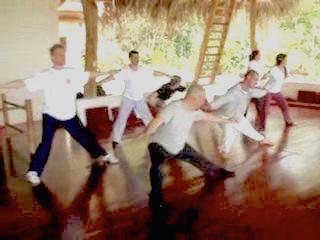
Dancing Cranes
Although the regional Taijiquan course on the Blue Mountain runs for only five days, our Shaolin Wahnam members attain in this course what many Taijiquan practitioners may not attain in ten years! Many people may find this statement very boastful, and that is their problem, not ours, but the statement is true. How many Taijiquan practitioners with more than ten years experience, for example, can develop internal force or apply Taijiquan techniques for combat, or know basic Taijiquan principles like differentiating yin-yang or flowing with an opponent’s momentum? All these and more are attained in this course.
Taiji Originates from Wuji and Returns to Wuji
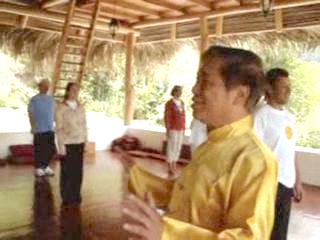
Taijiquan classics mention that Taiji originates from Wuji and ultimately returns to Wuji. Although this statement neatly sums up the aim, philosophy and practice of Taijiquan, not many people understand what it actually means. The meaning of this important principle is explained.
Click here to enter.
Philosophy and Methodology of Stance Training
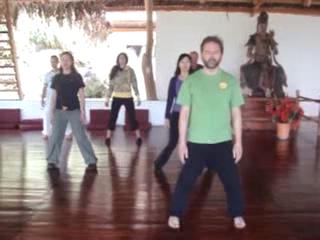
Do you know why zhan zhuang or stance training is very important? Do you know how to practice stance training correctly. This video series addresses these two important questions.
Click here to enter.
Experiencing the Subtle Joys of the Three-Circle Stance
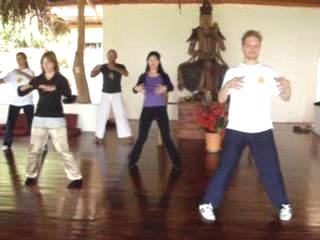
The most popular method to develop internal force in Taijiquan is to practice the Three-Circle Stance. This stance is so widely used in Taijiquan that it is sometimes called the Taiji Stance, though it is quite incorrect as it is also used in other styles of kungfu. Past masters recorded that when practiced correctly the Three-Circle Stance not only developed much internal force and mental clarity but also provided subtle joys
Click here to enter.
The Horse Riding, the Bow-Arrow and the False-Leg

The subtleties of the Horse-Riding Stance, the Bow-Arrow Stance and the False-Leg Stance are explained. Having the upper leg, the knee, the lower leg and the foot in proper alignment, for example, is important, failing which may result in hip, knee or ankle injuries. Body upright in the False-Leg Stance does not mean the body is perpendicular but slanting forward slightly. Do you know why? Also do you know why it is important to enjoy a chi flow after stance training?
Click here to enter.
The Four-Six, the Unicorn and the Single-Leg

The Four-Six Stance has a few other names, like the Triangle-Stance, the Three-Body Stance, the Three-Treasure Stance and the Stream-Character Stance. It is useful in certain situations. The Unicorn Stance is a very versatile stance. When it is transitional, it is called the Unicorn-Step. Do you know when it is advantageous to use the Single-Leg Stance instead of standing on both legs?
Click here to enter.
Flexibility Exercises that also Enhance your Internal Force

Besides building some solid stances, a good Taijiquan exponent should also be agile. This is a manifestation of yin-yang harmony. These five exercises which form the art of flexibility do not merely stretch your muscles but also give your internal force, vitality and longevity. Do you know how and why they can help you to achieve these benefits?
Click here to enter.
Importance of Body-Movement and Footwork

Body-movement and footwork, or "shen-fa" and "bu-fa" in Chinese, are very important in Taijiquan, but they are often neglected by many students. Incorrect body-movement and footwork not only affect combat efficiency but are also detrimental to health, causing disorders like knee injuries and back pain. Important principles like "differentiating yin-yang", "starting from the back leg" and "rotating the waist" ensure good body-movement and footwork.
Click here to enter.
Three Harmonies in Immortal Waves Sleeves
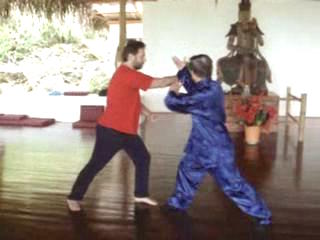
Footwork, body-movement and hand techniques constitute the three external harmonies. The three internal harmonies are essence, energy and mind. Having learnt appropriate footwork and body-movement, course participants progress to hand techniques, using the pattern “Immortal Waves Sleeves” as an example. Even without internal force but by applying the mechanics of footwork, body-movement and hand techniques correctly, an elderly lady can overcome a hefty man.
Click here to enter.
Chin-Na Techniques in Double Dragons and Pushing Boat
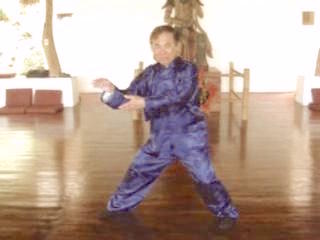
"Chin-na", an art of disabling opponents by using special ways of gripping, is an important aspect of Taijiquan, but not many Taijiquan practitioners may realize it. "Double Dragons Play with Pearl" and "Pushing Boat According to the Current of Flow" are two examples of chin-na techniques in Taijiquan. In "Double Dragon" the main movement comes from the waist and not from the hands. In "Pushing Boat" the palm of one hand should be placed on the wrist of the other hand, and not on the other palm.
Click here to enter.
Grasping Sparrow's Tail
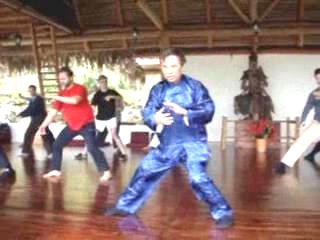
"Grasping Sparrow's Tail" is often regarded, especially by practitioners of Yang Style Taijiquan, as the prototype from which other Taijiquan patterns evolved. It is traditionally described as containing four fundamental techniques, namely "peng", "lu", "li" and "an", or "ward off", "roll back", "press" and "push". However, in our school we recognize a fifth technique, which is "chen" or "sink". We also give poetic names to the patterns, namely "Immortal Waves Sleeves", "Double Dragons Play with Pearl", "Pushing Boat According to Flow of Current", "Black Bear Sinks Hips", and "Open Window to Look at Moon".
Click here to enter.
Short and Medium Range in Stationary Pushing Hands
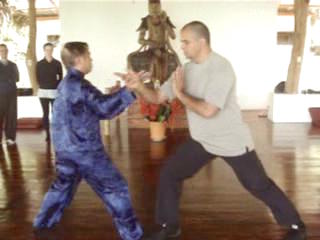
"Pushing Hands", or "Tui Sou", is an ingenious way to develop combat skills. There are two categories of "Pushing Hands", stationary and mobile. In "Stationary Pushing Hands" the attack is of short or medium range. The responder needs not move away but uses his hands or body-movement respectively to deflect the attack. If the attack is of long range, the responder needs to move away with his feet resulting in "Mobile Pushing Hands".
Click here to enter.
The Frontal Push in Mobile Pushing Hands
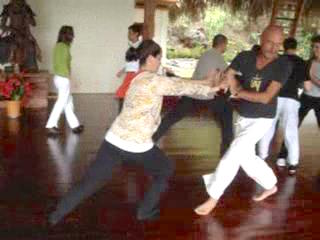
Many Taijiquan practitioners do not realize that "Pushing Hands" is meant to develop important combat skills, and not a routine exercise for demonstration. One very important skill is to cover yourself, including your groin, when pushing or attacking your opponent. "Mobile Pushing Hands" where attacks are of long range is exceedingly useful to develop good footwork. In this video series, the frontal push and its defence are shown.
Click here to enter.
Rolling and Stepping Forward and Backward
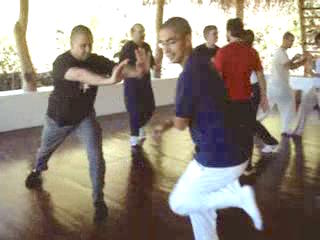
There are two methods in the frontal push, namely rolling forward and stepping forward. Covering yourselves and good footwork are important. You can also defend against the frontal push by rolling backward or stepping back. You also need to sink your body to get the best advantage. A good push consists of a good beginning where you cover yourselves adequately, a good progression where your movements are fluid, and a good conclusion where you complete in a stable stance.
Click here to enter.
Technical and Tactical Advantages
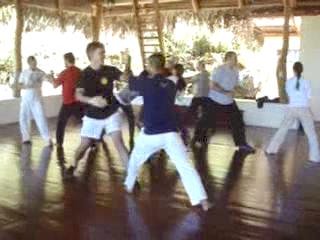
Can you remember the difference between tactical advantage and technical advantages? You can obtain some tactical advantages by rolling or stepping forward or backward, and most probably your opponents may not even realize it. If your opponent has tactical or technical advantages, you should neutralize them, or better still turn them around to your advantages.
Click here to enter.
Neutralizing, Exploiting and Creating Advantages
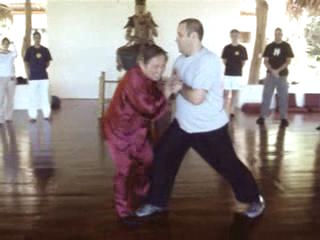
Combat is like a game of chess. In order to win you have to fight with advantages. If your opponent has advantages, you neutralize them. When you have advantages over your opponent, you exploit them. If you don't have any advantages, you create them. If your opponent is too heavy for you to push away from the front, for example, you move to his side where he is weakest and push him away with little effort.
Click here to enter.
Side Push from Left and from Right
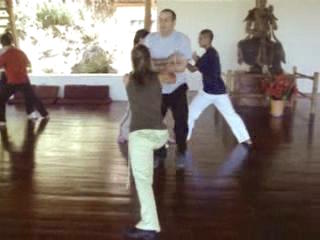
There is a kungfu tenet as follows. "If an opponent is weak, go straight in. If he is strong, go in from the side." Course participants learn to push from both their left and their right side. Some finer points concerning footwork when defending against a side push are also explained.
Click here to enter.
Skills and Techniques in Pushing Hands
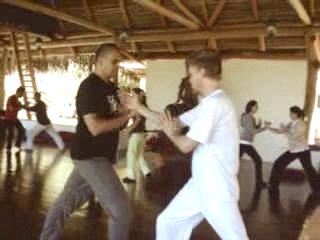
Techniques are of course important. Without techniques one would not know how to attack an opponent effectively, or how to defend against an attack. But soon course participants discover that the success of pushing an opponent away depends not so much on the techniques applied but more on the skills they use to execute the techniques. This is especially so when their opponent know the required techniques.
Click here to enter.
Picture-Perfect Form and Sophisticated Skills
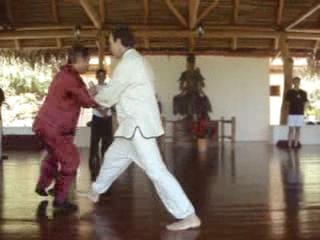
How would you ensure that you have the best advantages of the techniques you are applying? This is realized by having picture-perfect form. And a good way to realize this is to attain the three harmonies of legs, body and hands, which correspond to good stances, waist rotation and correct hand forms. Some finer points regarding skills -- like how to sense an opponent's force, how to flow with his momentum and how to deflect his attack -- are also explained.
Click here to enter.
Moving to an Opponent's Back
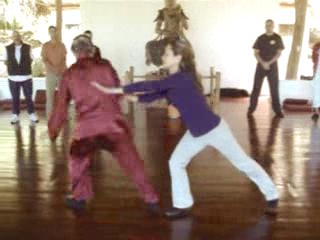
Imagine that while sparring or fighting with an opponent, he suddenly finds you have disappeared. This is because you have moved to his back. Moving to an opponent's back is an advanced skill. But course participants learn this skill quick efficiently. They also learn how to defend against such an attack.
Click here to enter.
Taijiquan Chin-Na Techniques and their Counters

Taijiquan is a complete martial art, and have all the four categories of attack, namely striking, kicking, felling and chin-na. Not many Taijiquan practitioners, however, know much about Taijiquan chin-na. Some Taijiquan chin-na techniques and their counters, as well as how to fell an opponent using the knee, are demonstated.
Click here to enter.
Progressing to Da Shou or Striking Hands
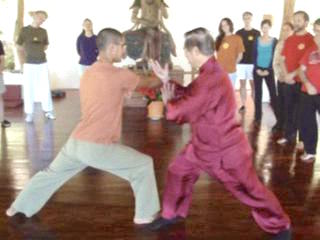
Many Taijiquan practitioners do not realize that although “Pushing Hands” is an excellent method to develop combat skills, it is not sufficient by itself for combat efficiency. To be combat efficient one must have techniques as well as skills. “Striking Hands” or “Da Shou” in Chinese, is meant to develop combat techniques and is the complimentary method to “Pushing Hands” in combat training. “Striking” or “Da” here is the shortened form for “striking, kicking, felling and chin-na”, the four categories of attack. This series shows the beginning of “Striking Hands” where participants learn to respond correctly and spontaneously to various attacks.
Click here to enter.
White Snake Shoots Venom and its Various Counters
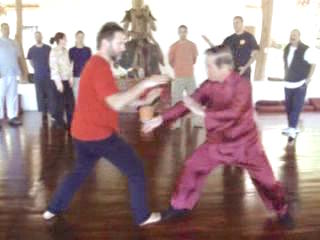
The Palm Thrust, executed in the pattern "White Snake Shoots Venon", is a deadly attack. There are various ways to counter it. One way is to ward off and counter strike in one movement. Another way is to tame the opponent thrusting attack, and counter strike simultaneously. A third way is to deflect and strike. Notice that all these movements are performed without moving the feet. Body-movement, however, is essential, especially when the opponent’s attack is of medium range. If it is of short range, it may not be necessary to move the body.
Click here to enter.
Striking the Opponents Top, Middle and Bottom Level
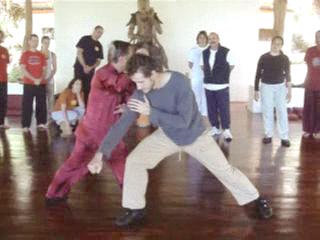
There are, of course, numerous other ways of countering an opponent’s White Snake Shoots Venom besides responding with another White Snake. You may, for example, respond with a mid-level palm strike, using Fierce Dragon Across Stream, or with a bottom-level vertical punch, using Sun Enters Lotus. These attacks represent the three levels of striking an opponent, namely striking his top level, his middle level and his bottom level. By maintaining these three levels of attack but changing your hand form or changing your stance, you can have a variety of different attacks. The defence, it is important to note, is not in blocking, but in body-movement.
Click here to enter.
Why do we Use Poise Patterns at the Start of Combat?
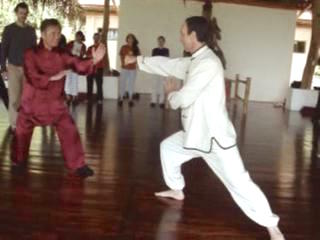
Why do combatants adopt a poise pattern at the start of combat? Certainly it is not to show that they practice kungfu (and then throw their kungfu patterns away when the combat starts). It is because adopting a poise pattern gives the combatants certain advantages. The poise pattern, for example, can keep an opponent at bay. When you move in to attack an opponent with a poise pattern, you have to open the way or close the opponent.
Click here to enter.
The Three Arrivals and the Four Preparations

Kungfu philosophy represents the great and invaluable body of knowledge kungfu masters of the past have left for us. Understanding kungfu philosophy, therefore, enables us to benefit form the great teachings of these masters. The combat philosophy of three arrivals and four preparations is explained. The three arrivals are the arrival of the heart, the arrival of the feet and the arrival of the hands. The four preparations are to be at the best ready position, to access the opponent, to look for opportunities and to move in swiftly and safely when an opportunity arises. Kungfu philosophy can, and should, be use to enrich our daily life.
Click here to enter.
Important Lessons in Initiating an Attack and in Responding to an Initial Attack

How to move in to attack, and how to respond to an initial attack are important lessons in combat efficiency. It is shocking that many martial artists today are ignorant of these lessons, with the result that they often offer their own defeat to their opponent, but their opponent does not know how to exploit the offer.
Click here to enter.
Third Class, Second Class and First Cl;ass Response
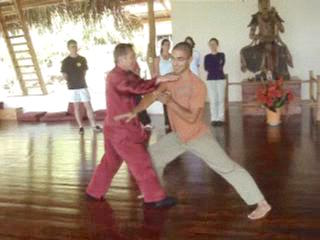
Do you know what is first class kungfu, second class kungfu and third class kungfu? Actually what is shown here is first class response, second class response and third class response. A first class response makes uses of principles like defence-cum-counter and starting later but arriving earlier. Good footwork, spacing and timing are essential.
Click here to enter.
Using Genuine Taijiquan Techniques in Attack and Defence
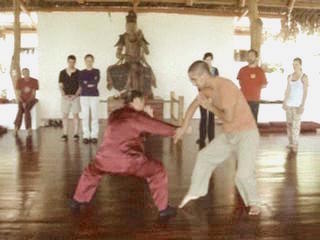
Two big problems in combat faced by most kungfu practitioners today are how to apply kungfu techniques coherently in attack, and how to respond to attacks using kungfu techniques correctly and spontaneously. “Striking Hands” as shown here is an excellent way to develop these skills and techniques. This video series shows how course participants learn to initiate top, middle and bottom strikes, and respond to them correctly and spontaneously using genuine Taijiquan patterns.
Click here to enter.
Abridged Combat Sequence 1 - Striking

Strikes can come in countless ways, but they can be classified into four main categories, namely top strikes, middle strikes, bottom strikes and side strikes. These four main types of strikes are formulated together into a combat sequence. By practicing this combat sequence, which is called Striking, one learns to apply Taijiquan techniques to initiate or respond to strikes correctly and spontaneously.
Click here to enter.
Themes for the Combat Sequences
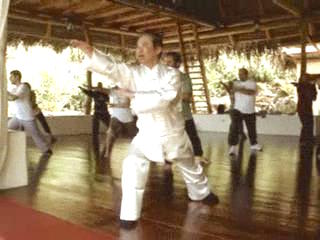
By practicing Abridged Combat Sequence 1, students learn how to counter all forms of hand strikes. But what about other forms of attacks? Kicks are introduced in Combat Sequence 2, felling techniques in Combat Sequence 3, and chin-na or gripping in Combat Sequence 4. These four combat sequences are linked together to form a set. At the start of the set, "Cloud Hands" is performed.
Click here to enter.
Abridged Combat Sequence 2 - Kicking
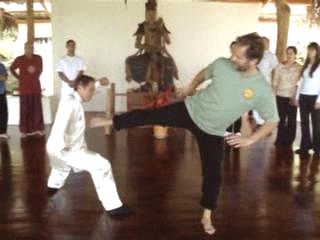
Like strikes, kicks can also come in numerous ways but they can be grouped into four main categories, namely top, middle, bottom and sides. As an attacker executes a side kick, a defender responds with "Striking Tiger Poise". The attacker continues with another side kick. Again the defender responds with "Striking Tiger Poise". "Striking Tiger Poise" is a very useful pattern. It can be used to defend against any kicks!
Click here to enter.
Continuation from One Sequence to Another Sequence
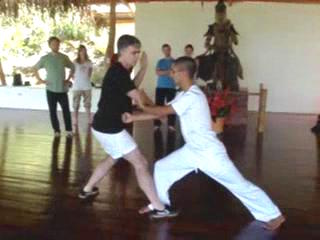
Course participants learn how to continue to another sequence after completing the first sequence. Footwork adjustment is often needed. Barry and Sifu Simon demonstrate how to initiate with Combat Sequence 1 and continue with Combat Sequence 2. Body-movement is very important in "Striking Tiger Poise". The arms must also be free from being kicked at.
Click here to enter.
Chasing After a Retreating Opponent

Amongst other skills, the video series shows how you can press into an opponent, here using appropriate footwork with the pattern "Fierce Dragon Across Stream" If the opponent is near, you may just use a left Bow-Arrow Stance. If he retreats, you can follow using a T-Step, and adjust your left leg backward into a right Bow-Arrow Stance. If he moves back further, you can press in by moving your right leg forward to a right Bow-Arrow Stance. All the movements must be smooth.
Click here to enter.
Carry Tiger Back to Mountain
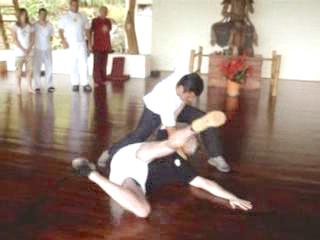
It is a mis-conception amongst many people that there are little or no felling techniques in Taijiquan. This series shows an effective Taijiquan technique to fell an opponent backward using "Carry Tiger Back to Mountain". The onus in a successful application of the technique lies in the stance, not in wrestling with the opponent. But before trying out this technique, one must know how to break fall so as not to be injured while falling.
Click here to enter.
Naughty Monkey Kicks at Tree
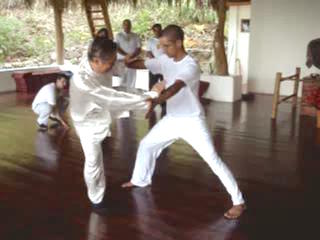
While "Striking Tiger Poise" can be used to defend against any kicks, "Naughty Monkey Kicks at Tree" can be used to counter any felling attacks. The secret lies in the tenet "Move Stance Change Step". While preparing yourself for this counter-attack, you must guard your groin while moving into a suitable position as well as guard the opponent’s hands against possible strikes while releasing his grip.
Click here to enter.
Abridged Combat Sequence 3 - Felling
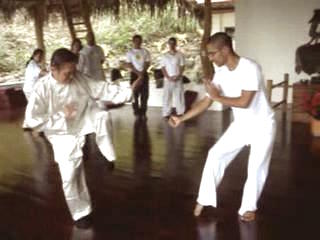
You may be surprised to know that this short combat sequence contains all the four categories of attack - striking, kicking, felling and chin-na - and their counters! The initiator moves in with a strike. As the responder counters with another strike, the initiator grips the responder with a chin-na technique and simultaneously tries to fell him. The responder counters with a kick, and the initiator responds by striking the kicking leg.
Click here to enter.
Eagle Claw in Taijiquan!
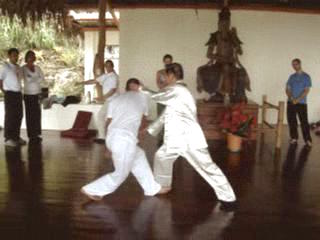
Many people are unaware that there are many chin-na or gripping techniques in Taijiquan. The Eagle Claw is very effective in implementing these Taijiquan chin-na techniques, suggesting that the bird the Patriarch Zhang San Feng saw fighting against a snake which inspired him to develop Taijiquan from Shaolin Kungfu might be an Eagle.
Click here to enter.
Hiding Flowers in the Sleeves

How would you counter an opponent gripping your arm with his two hands and pressing you onto the ground? An excellent counter is "Hide Flower in Sleeves". It is an excellent technique illustrating the Taijiquan principles of flowing with the opponent's momentum and using minimum force against maximum strength. Good footwork and body-movement are necessary. It is also crucial to guard against the opponent's hands for possible strikes.
Click here to enter.
Abridged Combat Sequence 4 – Chin-Na
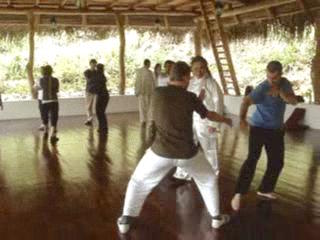
The four Abridged Combat Sequences cover the four main categories of attack and their defence. This video series shows Abridged Combat Sequence 4 - Chin-na. There are many chin-na techniques, but all of them may be classified into two main categories, namely single-hand chin-na and double-hand chin-na. Both these two categories are shown in this short combat sequence, applied using the patterns "Circulating Eagle Claw" and "Old Eagle Catches Snake".
Click here to enter.
The Four Attacks - Striking, Kicking, Felling and Chin-Na

Attacks can come in countless ways, but they all can be grouped into four categories, namely striking, kicking, felling and chin-na. These four attacks form the themes of the four abridged combat sequences. Hence, by practicing these four combat sequences well, you can handle any forms of attack.
Click here to enter.
Old Eagle Catches Snake in Remembrance of Zhang San Feng
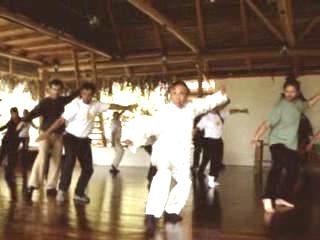
Patterns are meaningfully linked together to form sequences, and sequences are meaningfully linked together to form sets. The four Abridged Taijiquan Combat Sequences are linked here to form the set "Old Eagle Catches Snake". This set was formerly named "Taijiquan Four-Sequence Four-Attack Set". During the regional Taijiquan course on the Blue Mountain from 8th to 12th March 2009, Sifu Rama Roberto proposed a more poetic name, "Old Eagle Catches Snake", in remembrance of the historic event that inspired the Patriarch Zhang San Feng to evolve Taijiquan from Shaolin Kungfu.
Click here to enter.
From Combat Sequences to Free Sparring
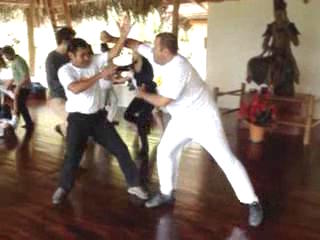
Combat sequences are pre-arranged. By themselves, they are inadequate for free sparring. But if students follow a systematic training programme, they can gradually release controls in the combat sequences and use them effectively for free sparring. The videos here show some of these processes. They are also having a lot of fun free sparring.
Click here to enter.
Taijiquan on the Blue Mountain - Life (Almost)
- Taiji Originates from Wuji and Returns to Wuji
- Philosophy and Methodology of Stance Training
- The Subtle Joys of the Three-Circle Stance
- The Horse-Riding, the Bow-Arrow and the False-Leg
- The Four-Six, the Unicorn and the Single-Leg
- Flexibility Exercises that also Enhance your Internal Force
- Importance of Body-Movement and Footwork
- Three Harmonies in Immortal Waves Sleeves
- Chin-Na Techniques in Double Dragons and Pushing Boat
- Grasping Sparrows Tail
- Short and Medium Range in Stationary Pushing Hands
- The Frontal Push in Mobile Pushing Hands
- Rolling and Stepping Forward and Backward
- Technical and Tactical Advantages
- Neutralizing, Exploiting and Creating Advantages
- Side Push from Left and from Right
- Skills and Techniques in Pushing Hands
- Picture-Perfect Form and Sophisticated Skills
- Moving to an Opponent's Back
- Taijiquan Chin-Na Techniques and their Counters
- Progressing to Da Shou or Striking Hands
- White Snake Shoots Venom and its Various Counters
- Striking the Opponents Top, Middle and Bottom Level
- Why do we Use Poise Patterns at the Start of Combat?
- The Three Arrivals and the Four Preparations
- Important Lessons in Initiating an Attack and in Responding to an Initial Attack
- Third Class, Second Class and First Cl;ass Response
- Using Genuine Taijiquan Techniques in Attack and Defence
- Abridged Combat Sequence 1 - Striking
- Themes for the Combat Sequences
- Abridged Combat Sequence 2 - Kicking
- Continuation from One Sequence to Another Sequence
- Chasing After a Retreating Opponent
- Carry Tiger Back to Mountain
- Naughty Monkey Kicks at Tree
- Abridged Combat Sequence 3 - Felling
- Eagle Claw in Taijiquan
- Hiding Flowers in the Sleeves
- Abridged Combat Sequence 4 – Chin-Na
- The Four Attacks - Striking, Kicking, Felling and Chin-Na
- Old Eagle Catches Snake in Remembrance of Zhang San Feng
- From Combat Sequences to Free Sparring
Courses and Classes
